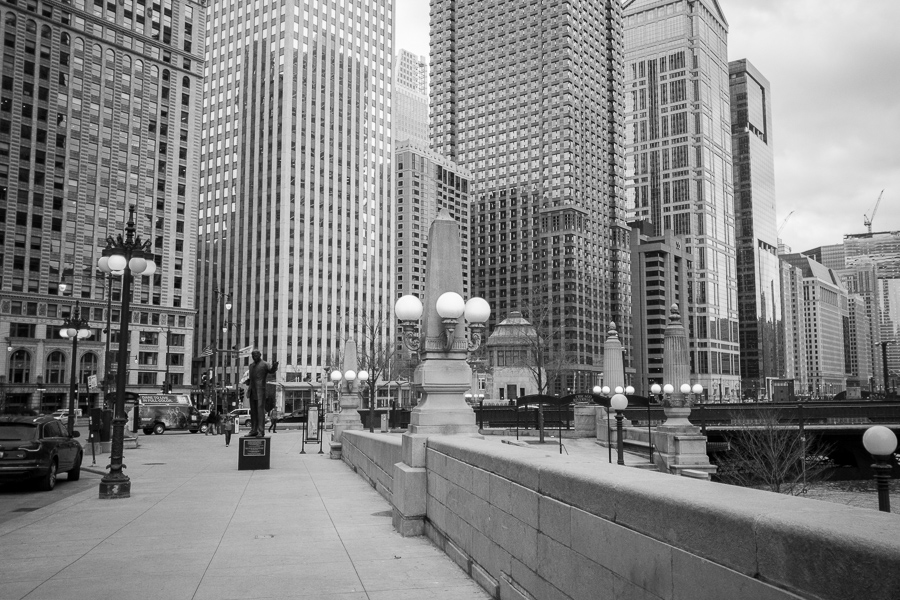I have a couple hours to kill in the Loop after having lunch with a friend. I don't really want caffeine or alcohol right now, which rules out the two classes of places to where I would most likely go. Then I remembered: there's a great big library here.
And yep, it looks like a library on the inside: shelves full of books, people reading, literary quotes on the walls, free WiFi. OK, that last bit isn't something I remember from the 1980s, but everything else is. They even have a shelf full of phone books.
OK, I've been here before, but still, I'm laughing at myself for not considering hanging out here before.
New Republic's Jeet Heer points out how the Republican Party's "Sourthern Strategy," going all the way back to the 1950s, led more or less directly to Donald Trump's campaign:
Far from being a “cancer” on Republicanism, or some jihadi-style radicalizer, he’s the natural evolutionary product of Republican platforms and strategies that stretch back to the very origins of modern conservatism in the 1950s and 1960s.
The racist voters swarming around Trump didn’t just pop out of nowhere. The Republicans have been courting them for decades now, in a dramatic break from the party’s origins. From its creation in 1854 in opposition to the expansion of slavery until the 1940s, the Republicans were the party of the North, and more anti-racist (albeit sometimes only marginally so) than the Democrats, whose most reliable base of support was the “solid” white South.
The Southern Strategy was the original sin that made Donald Trump possible. If Republican voters were anywhere near as diverse as the Democrats’, a candidate like Trump would have been marginalized quickly. Conservative elites can denounce Trump all they want as a “cancer” or an impostor. In truth, he is their true heir, the beneficiary of the policies the party has pursued for more than half a century.
It's a long-ish article, worth the time.
It's sunny and just above freezing today, and all our snow melted over the weekend. So let's just remember for a moment the weather in Chicago five years ago today:

And just two years ago today, we got our 34th consecutive day with snowfall.
So I'll take a snowless, above-freezing February 1st any year.
I've meant to post this for a while. Here's a photo looking south-west from a point just southwest of the intersection of Wacker and Michigan, here in Chicago, in April 1986:

And here's a similar view today. Note that you can no longer see the Thompson Center, City Hall, or anything else beyond the row of skyscrapers erected on Wacker between Wabash and Clark since then:

The photos aren't from the same vantage point, because this afternoon I only had my phone and not my SLR. I will try to get a photo from approximately the same location and using the same focal length (probably 210mm) soon.
On this day 180 years ago (28 January 1836), John L. Wilson purchased 33 hectares of land about 16 km from the city, by what is now 83rd and Cottage Grove. At the time it was a swath of prairie two hours outside Chicago. But through a series of missteps, slow City workers, and a very long-lived lawsuit, no one developed the land until 1940, by which time the city had grown to surround the lot on all sides:
The property was so remote—and the value so depressed—that nobody paid much attention to it for nearly 40 years. Then, in 1875, Isaac Palmer discovered that the original land patent had been issued in his name by mistake. He decided to cash in on it.
So now the matter went to the Superior Court of Cook County. By the time the Illinois Supreme Court got the case, the City of Chicago was involved, as well as the successors to Wilson and Palmer. In 1887 the Supreme Court ruled that the Wilson successors had legal title to the property. The City of Chicago also had a valid mortgage of $1,500 against it, with 10% annual interest dating back to the unpaid October 1836 mortgage.
Except there was yet another complication—most land records had been lost in the 1871 Chicago Fire. The further details of the dispute don’t need to be elaborated here, except to say that many lawyers were kept busy over the next fifty years, with the 80-acre plot remaining vacant while the rest of the area was built up.
On August 4, 1939 the drama ended. Compound interest over 102 years had ballooned the defaulted $1,500 mortgage to $34,755,000. Because of all the mistakes various governments had made over the years, Janet Fairbank—the last holder in the chain of title from original patentee John L. Wilson—was allowed to settle the debt and have clear title to the property on payment of $30,000.
For what it's worth, $1,500 in 1837 is about $38,000 today, and $34.8m in 1939 is around $590m today.
On this day in 1986, the Space Shuttle Challenger exploded over the Atlantic Ocean:
A little more than a minute after launch and high above Kennedy Space Center, shuttle Challenger was ripped apart after failure of a rubber seal allowed a spurt of rocket flame to ignite the spacecraft's giant fuel tank.
The roiling plume of Challenger's disintegration would sear an image in the nation's psyche that spoke of a particular sorrow; among seven astronauts killed 30 years ago [today] was teacher Christa McAuliffe.
"We will never forget them," said President Ronald Reagan in a broadcast hours later evoking triumph from tragedy. "The Challenger crew was pulling us into the future, and we'll continue to follow them."
Studying the decisions that led to Challenger launching that day uncovered serious cultural problems within NASA. It also led to groupthink about groupthink as people continually mis-applied the lessons from the disaster after not actually understanding them.
I remember exactly when I heard about the disaster: I was taking a final exam in high school when the PA broke in to tell everyone it had happened. (We still had to finish the exam.)
Via Schneier, it may be that England's political system was stable:
For over a century the longbow reigned as undisputed king of medieval European missile weapons. Yet only England used the longbow as a mainstay in its military arsenal; France and Scotland clung to the technologically inferior crossbow. This longbow puzzle has perplexed historians for decades. We resolve it by developing a theory of institutionally constrained technology adoption. Unlike the crossbow, the longbow was cheap and easy to make and required rulers who adopted the weapon to train large numbers of citizens in its use. These features enabled usurping nobles whose rulers adopted the longbow to potentially organize effective rebellions against them. Rulers choosing between missile technologies thus confronted a trade-off with respect to internal and external security. England alone in late medieval Europe was sufficiently politically stable to allow its rulers the first-best technology option. In France and Scotland political instability prevailed, constraining rulers in these nations to the crossbow.
I wonder, though, what that says about the United States allowing its citizens to own the deadliest weapons on earth...
This video shows the point-of-view of an engineer on the Chicago North Shore and Milwaukee Railroad in 1945. From Linden Street in Wilmette on up to Waukegan, none of these tracks exists anymore; it's now the North Shore Trail, which I've ridden and walked on for most of my life.
Check it out: